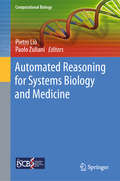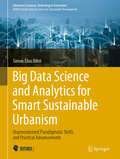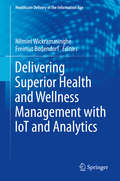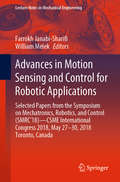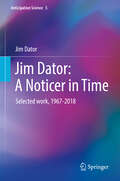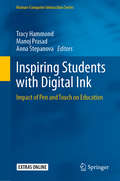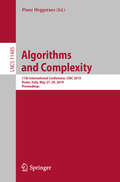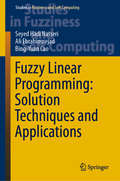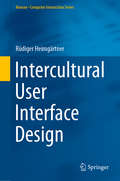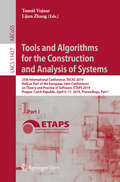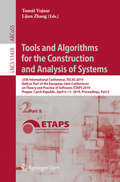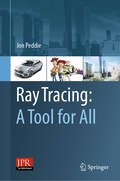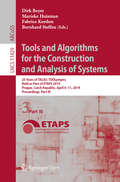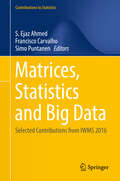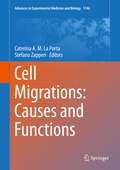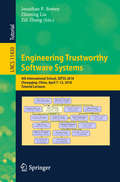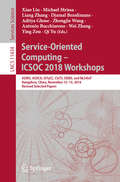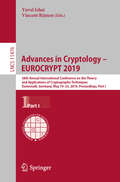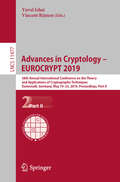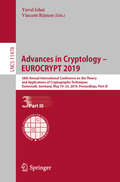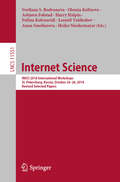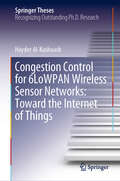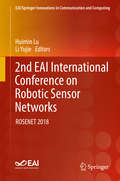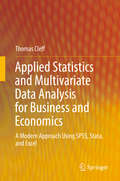- Table View
- List View
Automated Reasoning for Systems Biology and Medicine (Computational Biology #30)
by Pietro Liò Paolo ZulianiThis book presents outstanding contributions in an exciting, new and multidisciplinary research area: the application of formal, automated reasoning techniques to analyse complex models in systems biology and systems medicine. Automated reasoning is a field of computer science devoted to the development of algorithms that yield trustworthy answers, providing a basis of sound logical reasoning. For example, in the semiconductor industry formal verification is instrumental to ensuring that chip designs are free of defects (or “bugs”). Over the past 15 years, systems biology and systems medicine have been introduced in an attempt to understand the enormous complexity of life from a computational point of view. This has generated a wealth of new knowledge in the form of computational models, whose staggering complexity makes manual analysis methods infeasible. Sound, trusted, and automated means of analysing the models are thus required in order to be able to trust their conclusions. Above all, this is crucial to engineering safe biomedical devices and to reducing our reliance on wet-lab experiments and clinical trials, which will in turn produce lower economic and societal costs. Some examples of the questions addressed here include: Can we automatically adjust medications for patients with multiple chronic conditions? Can we verify that an artificial pancreas system delivers insulin in a way that ensures Type 1 diabetic patients never suffer from hyperglycaemia or hypoglycaemia? And lastly, can we predict what kind of mutations a cancer cell is likely to undergo? This book brings together leading researchers from a number of highly interdisciplinary areas, including: · Parameter inference from time series · Model selection · Network structure identification · Machine learning · Systems medicine · Hypothesis generation from experimental data · Systems biology, systems medicine, and digital pathology · Verification of biomedical devices “This book presents a comprehensive spectrum of model-focused analysis techniques for biological systems ...an essential resource for tracking the developments of a fast moving field that promises to revolutionize biology and medicine by the automated analysis of models and data.”Prof Luca Cardelli FRS, University of Oxford
Big Data Science and Analytics for Smart Sustainable Urbanism: Unprecedented Paradigmatic Shifts and Practical Advancements (Advances in Science, Technology & Innovation)
by Simon Elias BibriWe are living at the dawn of what has been termed ‘the fourth paradigm of science,’ a scientific revolution that is marked by both the emergence of big data science and analytics, and by the increasing adoption of the underlying technologies in scientific and scholarly research practices. Everything about science development or knowledge production is fundamentally changing thanks to the ever-increasing deluge of data. This is the primary fuel of the new age, which powerful computational processes or analytics algorithms are using to generate valuable knowledge for enhanced decision-making, and deep insights pertaining to a wide variety of practical uses and applications. This book addresses the complex interplay of the scientific, technological, and social dimensions of the city, and what it entails in terms of the systemic implications for smart sustainable urbanism. In concrete terms, it explores the interdisciplinary and transdisciplinary field of smart sustainable urbanism and the unprecedented paradigmatic shifts and practical advances it is undergoing in light of big data science and analytics. This new era of science and technology embodies an unprecedentedly transformative and constitutive power—manifested not only in the form of revolutionizing science and transforming knowledge, but also in advancing social practices, producing new discourses, catalyzing major shifts, and fostering societal transitions. Of particular relevance, it is instigating a massive change in the way both smart cities and sustainable cities are studied and understood, and in how they are planned, designed, operated, managed, and governed in the face of urbanization. This relates to what has been dubbed data-driven smart sustainable urbanism, an emerging approach based on a computational understanding of city systems and processes that reduces urban life to logical and algorithmic rules and procedures, while also harnessing urban big data to provide a more holistic and integrated view or synoptic intelligence of the city. This is increasingly being directed towards improving, advancing, and maintaining the contribution of both sustainable cities and smart cities to the goals of sustainable development. This timely and multifaceted book is aimed at a broad readership. As such, it will appeal to urban scientists, data scientists, urbanists, planners, engineers, designers, policymakers, philosophers of science, and futurists, as well as all readers interested in an overview of the pivotal role of big data science and analytics in advancing every academic discipline and social practice concerned with data–intensive science and its application, particularly in relation to sustainability.
Delivering Superior Health and Wellness Management with IoT and Analytics (Healthcare Delivery in the Information Age)
by Nilmini Wickramasinghe Freimut BodendorfThis in-depth book addresses a key void in the literature surrounding the Internet of Things (IoT) and health. By systematically evaluating the benefits of mobile, wireless, and sensor-based IoT technologies when used in health and wellness contexts, the book sheds light on the next frontier for healthcare delivery. These technologies generate data with significant potential to enable superior care delivery, self-empowerment, and wellness management. Collecting valuable insights and recommendations in one accessible volume, chapter authors identify key areas in health and wellness where IoT can be used, highlighting the benefits, barriers, and facilitators of these technologies as well as suggesting areas for improvement in current policy and regulations.Four overarching themes provide a suitable setting to examine the critical insights presented in the 31 chapters:Mobile- and sensor-based solutionsOpportunities to incorporate critical aspects of analytics to provide superior insights and thus support better decision-makingCritical issues around aspects of IoT in healthcare contextsApplications of portals in healthcare contextsA comprehensive overview that introduces the critical issues regarding the role of IoT technologies for health, Delivering Superior Health and Wellness Management with IoT and Analytics paves the way for scholars, practitioners, students, and other stakeholders to understand how to substantially improve health and wellness management on a global scale.
Advances in Motion Sensing and Control for Robotic Applications: Selected Papers from the Symposium on Mechatronics, Robotics, and Control (SMRC’18)- CSME International Congress 2018, May 27-30, 2018 Toronto, Canada (Lecture Notes in Mechanical Engineering)
by Farrokh Janabi-Sharifi William MelekThis book reports on advances in sensing, modeling and control methods for different robotic platforms such as multi-degree of freedom robotic arms, unmanned aerial vehicles and autonomous mobile platforms. Based on 2018 Symposium on Mechatronics, Robotics, and Control (SMTRC’18), held as part of the 2018 CSME International Congress, in York University, Toronto, Canada, the book covers a variety of topics, from filtering and state estimation to adaptive control of reconfigurable robots and more. Next-generation systems with advanced control, planning, perception and interaction capabilities will achieve functionalities far beyond today’s technology. Two key challenges remaining for advanced robot technologies are related to sensing and control in robotic systems. Advanced perception is needed to navigate changing environments. Adaptive and intelligent control systems must be developed to enable operation in unstructured and dynamic environments. The selected chapters in this book focus on both of the aforementioned areas and highlight the main trends and challenges in robot sensing and control. The first part of the book introduces chapters which focus on advanced perception and sensing for robotics applications. They include sensor filtering and state estimation for bipedal robots and motion capture systems analysis. The second part focuses on different modeling and control methods for robotic systems including flight control for UAVs, multi-variable robust control for modular and reconfigurable robotics and control for precision micromanipulation.
Jim Dator: Selected work, 1967-2018 (Anticipation Science #5)
by Jim DatorThis book features a selection of the published writings and public presentations of Jim Dator. Most of the chapters are directly concerned with futures studies and ideas about the futures. The topic covers many disciplines and subjects. It is also concerned with many different parts of the world, even Mars. In addition, a few of the earlier papers contained here are about more conventional topics in politics and religion.The collection spans a more than 50 year period of thought, reflection, and instruction. In particular, the papers examine six main topics. These include meditations on the very nature of future studies, visions of preferred futures, ideas about alternative futures, and details on future theories and methods. Coverage also considers such specific topics as AI and robots, the environment, food, culture, energy, families, future generations, and more.Overall, these papers help readers gain insight into what it takes to weave together alternative images of the future in useful ways. They also reveal cross-disciplinary patterns in key fields of human endeavor that will help readers better understand trends and emerging issues.
Inspiring Students with Digital Ink: Impact of Pen and Touch on Education (Human–Computer Interaction Series)
by Tracy Hammond Manoj Prasad Anna StepanovaThis book highlights the latest research in pen and touch, its current use in STEM classrooms, sketching and haptics technologies. Computer and educational scientists from academia and industry presented their research at the Conference on Pen and Touch Technology on Education (CPTTE) 2017 on the advancement of digital ink technology and its applications for college and K-12 classrooms. This book is the synthesis of the presented results and the ideas generated from conference discussions. This volume contains seven parts; exploring topics like sketching forensics, teaching STEM, sketch recognition applications, creating a learning environment with sketching, teaching to sketch, and haptics. The book focuses on intelligent systems using digital ink that enable pen and touch interaction that teach and inspire students. Inspiring Students through Digital Ink is a must-read for anyone wanting to improve today’s student experiences and apply innovative approaches in the classroom. Also highlighted are current and future directions in pen and touch research.
Algorithms and Complexity: 11th International Conference, CIAC 2019, Rome, Italy, May 27–29, 2019, Proceedings (Lecture Notes in Computer Science #11485)
by Pinar HeggernesThis book constitutes the refereed conference proceedings of the 11th International Conference on Algorithms and Complexity, CIAC 2019, held in Rome, Italy, in May 2019. The 30 full papers were carefully reviewed and selected from 95 submissions. The International Conference on Algorithms and Complexity is intended to provide a forum for researchers working in all aspects of computational complexity and the use, design, analysis and experimentation of efficient algorithms and data structures. The papers present original research in the theory and applications of algorithms and computational complexity.
Fuzzy Linear Programming: Solution Techniques and Applications (Studies in Fuzziness and Soft Computing #379)
by Seyed Hadi Nasseri Ali Ebrahimnejad Bing-Yuan CaoThis book presents the necessary and essential backgrounds of fuzzy set theory and linear programming, particularly a broad range of common Fuzzy Linear Programming (FLP) models and related, convenient solution techniques. These models and methods belong to three common classes of fuzzy linear programming, namely: (i) FLP problems in which all coefficients are fuzzy numbers, (ii) FLP problems in which the right-hand-side vectors and the decision variables are fuzzy numbers, and (iii) FLP problems in which the cost coefficients, the right-hand-side vectors and the decision variables are fuzzy numbers. The book essentially generalizes the well-known solution algorithms used in linear programming to the fuzzy environment. Accordingly, it can be used not only as a textbook, teaching material or reference book for undergraduate and graduate students in courses on applied mathematics, computer science, management science, industrial engineering, artificial intelligence, fuzzy information processes, and operations research, but can also serve as a reference book for researchers in these fields, especially those engaged in optimization and soft computing. For textbook purposes, it also includes simple and illustrative examples to help readers who are new to the field.
Intercultural User Interface Design (Human–Computer Interaction Series)
by Rüdiger HeimgärtnerThe path for developing an internationally usable product with a human-machine interface is described in this textbook, from theory to conception and from design to practical implementation. The most important concepts in the fields of philosophy, communication, culture and Ethnocomputing as the basis of intercultural user interface design are explained. The book presents directly usable and implementable knowledge that is relevant for the processes of internationalization and localization of software. Aspects of software ergonomics, software engineering and human-centered design are presented in an intercultural context; general and concrete recommendations and checklists for immediate use in product design are also provided. Each chapter includes the target message, its motivation and theoretical justification as well as the practical methods to achieve the intended benefit from the respective topic. The book opens with an introduction illuminating the background necessary for taking culture into account in Human Computer Interaction (HCI) design. Definitions of concepts are followed by a historical overview of the importance of taking culture into account in HCI design. Subsequently, the structures, processes, methods, models, and approaches concerning the relationship between culture and HCI design are illustrated to cover the most important questions in practice.
Tools and Algorithms for the Construction and Analysis of Systems: 25th International Conference, TACAS 2019, Held as Part of the European Joint Conferences on Theory and Practice of Software, ETAPS 2019, Prague, Czech Republic, April 6–11, 2019, Proceedings, Part I (Lecture Notes in Computer Science #11427)
by Tomáš Vojnar Lijun ZhangThis book is Open Access under a CC BY licence. The LNCS 11427 and 11428 proceedings set constitutes the proceedings of the 25th International Conference on Tools and Algorithms for the Construction and Analysis of Systems, TACAS 2019, which took place in Prague, Czech Republic, in April 2019, held as part of the European Joint Conferences on Theory and Practice of Software, ETAPS 2019. The total of 42 full and 8 short tool demo papers presented in these volumes was carefully reviewed and selected from 164 submissions. The papers are organized in topical sections as follows: Part I: SAT and SMT, SAT solving and theorem proving; verification and analysis; model checking; tool demo; and machine learning. Part II: concurrent and distributed systems; monitoring and runtime verification; hybrid and stochastic systems; synthesis; symbolic verification; and safety and fault-tolerant systems.
Tools and Algorithms for the Construction and Analysis of Systems: 25th International Conference, TACAS 2019, Held as Part of the European Joint Conferences on Theory and Practice of Software, ETAPS 2019, Prague, Czech Republic, April 6–11, 2019, Proceedings, Part II (Lecture Notes in Computer Science #11428)
by Tomáš Vojnar Lijun ZhangThis book is Open Access under a CC BY licence. The LNCS 11427 and 11428 proceedings set constitutes the proceedings of the 25th International Conference on Tools and Algorithms for the Construction and Analysis of Systems, TACAS 2019, which took place in Prague, Czech Republic, in April 2019, held as part of the European Joint Conferences on Theory and Practice of Software, ETAPS 2019. The total of 42 full and 8 short tool demo papers presented in these volumes was carefully reviewed and selected from 164 submissions. The papers are organized in topical sections as follows: Part I: SAT and SMT, SAT solving and theorem proving; verification and analysis; model checking; tool demo; and machine learning. Part II: concurrent and distributed systems; monitoring and runtime verification; hybrid and stochastic systems; synthesis; symbolic verification; and safety and fault-tolerant systems.
Ray Tracing: A Tool for All
by Jon PeddieThis is the first book to offer a comprehensive overview for anyone wanting to understand the benefits and opportunities of ray tracing, as well as some of the challenges, without having to learn how to program or be an optics scientist.It demystifies ray tracing and brings forward the need and benefit of using ray tracing throughout the development of a film, product, or building — from pitch to prototype to marketing.Ray Tracing and Rendering clarifies the difference between conventional faked rendering and physically correct, photo-realistic ray traced rendering, and explains how programmer’s time, and backend compositing time are saved while producing more accurate representations with 3D models that move.Often considered an esoteric subject the author takes ray tracing out of the confines of the programmer’s lair and shows how all levels of users from concept to construction and sales can benefit without being forced to be a practitioner. It treats both theoretical and practical aspects of the subject as well as giving insights into all the major ray tracing programs and how many of them came about.It will enrich the readers’ understanding of what a difference an accurate high-fidelity image can make to the viewer — our eyes are incredibly sensitive to flaws and distortions and we quickly disregard things that look phony or unreal. Such dismissal by a potential user or customer can spell disaster for a supplier, producer, or developer. If it looks real it will sell, even if it is a fantasy animation. Ray tracing is now within reach of every producer and marketeer, and at prices one can afford, and with production times that meet the demands of today’s fast world.
Tools and Algorithms for the Construction and Analysis of Systems: 25 Years of TACAS: TOOLympics, Held as Part of ETAPS 2019, Prague, Czech Republic, April 6–11, 2019, Proceedings, Part III (Lecture Notes in Computer Science #11429)
by Dirk Beyer Marieke Huisman Fabrice Kordon Bernhard SteffenThis book is Open Access under a CC BY licence. This book, LNCS 11429, is part III of the proceedings of the 25th International Conference on Tools and Algorithms for the Construction and Analysis of Systems, TACAS 2019, which took place in Prague, Czech Republic, in April 2019, held as part of the European Joint Conferences on Theory and Practice of Software, ETAPS 2019. It's a special volume on the occasion of the 25 year anniversary of TACAS.
Tools and Algorithms for the Construction and Analysis of Systems: 25 Years of TACAS: TOOLympics, Held as Part of ETAPS 2019, Prague, Czech Republic, April 6–11, 2019, Proceedings, Part III (Lecture Notes in Computer Science #11429)
by Fabrice Kordon Marieke Huisman Bernhard Steffen Dirk BeyerThis book is Open Access under a CC BY licence. This book, LNCS 11429, is part III of the proceedings of the 25th International Conference on Tools and Algorithms for the Construction and Analysis of Systems, TACAS 2019, which took place in Prague, Czech Republic, in April 2019, held as part of the European Joint Conferences on Theory and Practice of Software, ETAPS 2019. It's a special volume on the occasion of the 25 year anniversary of TACAS.
Matrices, Statistics and Big Data: Selected Contributions from IWMS 2016 (Contributions to Statistics)
by S. Ejaz Ahmed Francisco Carvalho Simo PuntanenThis volume features selected, refereed papers on various aspects of statistics, matrix theory and its applications to statistics, as well as related numerical linear algebra topics and numerical solution methods, which are relevant for problems arising in statistics and in big data. The contributions were originally presented at the 25th International Workshop on Matrices and Statistics (IWMS 2016), held in Funchal (Madeira), Portugal on June 6-9, 2016. The IWMS workshop series brings together statisticians, computer scientists, data scientists and mathematicians, helping them better understand each other’s tools, and fostering new collaborations at the interface of matrix theory and statistics.
Cell Migrations: Causes and Functions (Advances in Experimental Medicine and Biology #1146)
by Caterina A. M. La Porta Stefano ZapperiCell migration plays an important role during development and in many physiological and pathological processes, from wound healing to cancer. This edited volume presents a collection of contributions meant to illustrate the state of the art on this topic from an interdisciplinary perspective.Readers will find a detailed discussion of the properties of individual and collective cell migration, including the associated biochemical regulation and important biophysical and biomechanical aspects. The book includes information on the latest experimental techniques employed to study cell migration, from microfluidics to traction force microscopy, as well as the latest theoretical and computational models used to interpret the experimental data. Finally, the role of cell migration in cancer and in development is also reviewed.The contents of this work should appeal to students and researchers in biology and biophysics who want to get up to date on the latest interdisciplinary development in this broad field of research. The chapters are written in a self-contained form and can also be used as individual articles.
Engineering Trustworthy Software Systems: 4th International School, SETSS 2018, Chongqing, China, April 7–12, 2018, Tutorial Lectures (Lecture Notes in Computer Science #11430)
by Jonathan P. Bowen Zhiming Liu Zili ZhangThis volume contains lectures on leading-edge research in methods and tools for use in computer system engineering; at the 4th International School on Engineering Trustworthy Software Systems, SETSS 2018, held in April 2018 at Southwest University in Chongqing, China.The five chapters in this volume provide an overview of research in the frontier of theories, methods, and tools for software modelling, design, and verification. The topics covered in these chapter include Software Verification with Whiley, Learning Büchi Automata and Its Applications, Security in IoT Applications, Programming in Z3, and The Impact of Alan Turing: Formal Methods and Beyond. The volume provides a useful resource for postgraduate students, researchers, academics, and engineers in industry, who are interested in theory, methods, and tools for the development of trustworthy software.
Service-Oriented Computing – ICSOC 2018 Workshops: ADMS, ASOCA, ISYyCC, CloTS, DDBS, and NLS4IoT, Hangzhou, China, November 12–15, 2018, Revised Selected Papers (Lecture Notes in Computer Science #11434)
by Xiao Liu Michael Mrissa Liang Zhang Djamal Benslimane Aditya Ghose Zhongjie Wang Antonio Bucchiarone Wei Zhang Ying Zou Qi YuThis book constitutes the revised selected papers of the scientific satellite events that were held in conjunction with the 16th International Conference on Service-Oriented Computing, ICSOC 2018, held in Hangzhou, China, in November 2018.The ICSOC 2018 workshop track consisted of six workshops on a wide range of topics that fall into the general area of service computing. A special focus this year was on Internet of Things, Data Analytics, and Smart Services: First International Workshop on Data-Driven Business Services (DDBS)First International Workshop on Networked Learning Systems for Secured IoT Services and Its Applications (NLS4IoT)8th International Workshop on Context-Aware and IoT Services (CIoTS)Third International Workshop on Adaptive Service-oriented and Cloud Applications (ASOCA2018)Third International Workshop on IoT Systems for Context-aware Computing (ISyCC)First International Workshop on AI and Data Mining for Services (ADMS)
Advances in Cryptology – EUROCRYPT 2019: 38th Annual International Conference on the Theory and Applications of Cryptographic Techniques, Darmstadt, Germany, May 19–23, 2019, Proceedings, Part I (Lecture Notes in Computer Science #11476)
by Yuval Ishai Vincent RijmenThe three volume-set LNCS 11476, 11477, and 11478 constitute the thoroughly refereed proceedings of the 38th Annual International Conference on the Theory and Applications of Cryptographic Techniques, EUROCRYPT 2019,held in Darmstadt, Germany, in May 2019.The 76 full papers presented were carefully reviewed and selected from 327 submissions. The papers are organized into the following topical sections: ABE and CCA security; succinct arguments and secure messaging; obfuscation; block ciphers; differential privacy; bounds for symmetric cryptography; non-malleability; blockchain and consensus; homomorphic primitives; standards; searchable encryption and ORAM; proofs of work and space; secure computation; quantum, secure computation and NIZK, lattice-based cryptography; foundations; efficient secure computation; signatures; information-theoretic cryptography; and cryptanalysis.
Advances in Cryptology – EUROCRYPT 2019: 38th Annual International Conference on the Theory and Applications of Cryptographic Techniques, Darmstadt, Germany, May 19–23, 2019, Proceedings, Part II (Lecture Notes in Computer Science #11477)
by Yuval Ishai Vincent RijmenThe three volume-set LNCS 11476, 11477, and 11478 constitute the thoroughly refereed proceedings of the 38th Annual International Conference on the Theory and Applications of Cryptographic Techniques, EUROCRYPT 2019,held in Darmstadt, Germany, in May 2019.The 76 full papers presented were carefully reviewed and selected from 327 submissions. The papers are organized into the following topical sections: ABE and CCA security; succinct arguments and secure messaging; obfuscation; block ciphers; differential privacy; bounds for symmetric cryptography; non-malleability; blockchain and consensus; homomorphic primitives; standards; searchable encryption and ORAM; proofs of work and space; secure computation; quantum, secure computation and NIZK, lattice-based cryptography; foundations; efficient secure computation; signatures; information-theoretic cryptography; and cryptanalysis.
Advances in Cryptology – EUROCRYPT 2019: 38th Annual International Conference on the Theory and Applications of Cryptographic Techniques, Darmstadt, Germany, May 19–23, 2019, Proceedings, Part III (Lecture Notes in Computer Science #11478)
by Yuval Ishai Vincent RijmenThe three volume-set LNCS 11476, 11477, and 11478 constitute the thoroughly refereed proceedings of the 38th Annual International Conference on the Theory and Applications of Cryptographic Techniques, EUROCRYPT 2019,held in Darmstadt, Germany, in May 2019.The 76 full papers presented were carefully reviewed and selected from 327 submissions. The papers are organized into the following topical sections: ABE and CCA security; succinct arguments and secure messaging; obfuscation; block ciphers; differential privacy; bounds for symmetric cryptography; non-malleability; blockchain and consensus; homomorphic primitives; standards; searchable encryption and ORAM; proofs of work and space; secure computation; quantum, secure computation and NIZK, lattice-based cryptography; foundations; efficient secure computation; signatures; information-theoretic cryptography; and cryptanalysis.
Internet Science: INSCI 2018 International Workshops, St. Petersburg, Russia, October 24–26, 2018, Revised Selected Papers (Lecture Notes in Computer Science #11551)
by Svetlana S. Bodrunova Olessia Koltsova Asbjørn Følstad Harry Halpin Polina Kolozaridi Leonid Yuldashev Anna Smoliarova Heiko NiedermayerThis book constitutes the refereed post-conference proceedings of 4 workshops, held at the 5th International Conference on Internet Science, St. Petersburg, Russia, in October 2018: Workshop 1 : Detecting Social Problems in Online Content, Workshop 2: CONVERSATIONS, Workshop 3: The Future of Decentralized Governance: A Workshop on Encryption,Blockchains, and Personal Data, and Workshop 4: Internet as an issue: An international workshop on governmentand media narratives. The 20 full papers presented together with 4 short papers were carefully reviewed and selected from 38 submissions. The contributions of the Workshop 1: Detecting Social Problems in Online Content has united Russian scholars who work upon Russian-language datasets. Workshop 2: CONVERSATIONS: An international workshop on chatbot research and design regularly discusses the novel issues in their research and production area. Workshop 3: The Future of Decentralized Governance: A Workshop on Encryption, Blockchains, and Personal Data. At this workshop scholars and industry representatives from France, the Netherlands, the UK, and Russia have discussed distributed governance technologies based on blockchain and other privacy-protecting technologies. Workshop 4: Internet as an issue: An international workshop on government and media narratives took a rare approach and regarded Internet as a focus for public discussion.
Congestion Control for 6LoWPAN Wireless Sensor Networks: Toward the Internet of Things (Springer Theses)
by Hayder Al-KashoashThe Internet of Things (IoT) is the next big challenge for the research community. The IPv6 over low power wireless personal area network (6LoWPAN) protocol stack is considered a key part of the IoT. In 6LoWPAN networks, heavy network traffic causes congestion which significantly degrades network performance and impacts on quality of service aspects. This book presents a concrete, solid and logically ordered work on congestion control for 6LoWPAN networks as a step toward successful implementation of the IoT and supporting the IoT application requirements. The book addresses the congestion control issue in 6LoWPAN networks and presents a comprehensive literature review on congestion control for WSNs and 6LoWPAN networks. An extensive congestion analysis and assessment for 6LoWPAN networks is explored through analytical modelling, simulations and real experiments. A number of congestion control mechanisms and algorithms are proposed to mitigate and solve the congestion problem in 6LoWPAN networks by using and utilizing the non-cooperative game theory, multi-attribute decision making and network utility maximization framework. The proposed algorithms are aware of node priorities and application priorities to support the IoT application requirements and improve network performance in terms of throughput, end-to-end delay, energy consumption, number of lost packets and weighted fairness index.
2nd EAI International Conference on Robotic Sensor Networks: ROSENET 2018 (EAI/Springer Innovations in Communication and Computing)
by Huimin Lu Li YujieThis book provides scientific research into Cognitive Internet of Things for Smart Society, with papers presented at the 2nd EAI International Conference on Robotic Sensor Networks. The conference explores the integration of networks and robotic technologies, which has become a topic of increasing interest for both researchers and developers from academic fields and industries worldwide. The authors posit that big networks will be the main approach to the next generation of robotic research, with the explosive number of networks models and increasing computational power of computers significantly extending the number of potential applications for robotic technologies while also bringing new challenges to the network's community. The 2nd EAI International Conference on Robotic Sensor Networks was held 25-26 August 2018 at the Kitakyushu International Conference Center (MICE), Kitakyushu, Japan.
Applied Statistics and Multivariate Data Analysis for Business and Economics: A Modern Approach Using SPSS, Stata, and Excel
by Thomas CleffThis textbook will familiarize students in economics and business, as well as practitioners, with the basic principles, techniques, and applications of applied statistics, statistical testing, and multivariate data analysis. Drawing on practical examples from the business world, it demonstrates the methods of univariate, bivariate, and multivariate statistical analysis. The textbook covers a range of topics, from data collection and scaling to the presentation and simple univariate analysis of quantitative data, while also providing advanced analytical procedures for assessing multivariate relationships. Accordingly, it addresses all topics typically covered in university courses on statistics and advanced applied data analysis. In addition, it does not limit itself to presenting applied methods, but also discusses the related use of Excel, SPSS, and Stata.
